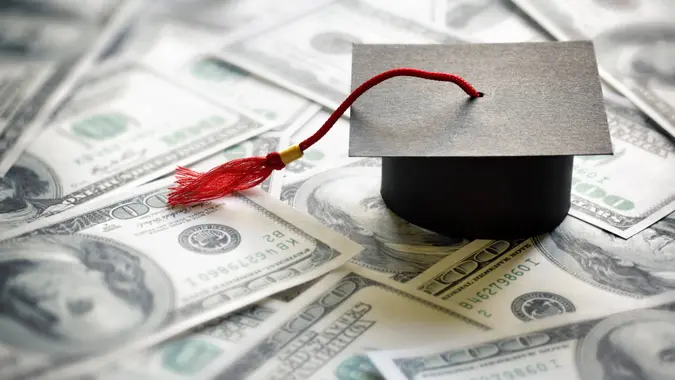Car Loan Debt Is Soaring — Here’s What You Should Do If You’re Falling Behind

Commitment to Our Readers
GOBankingRates' editorial team is committed to bringing you unbiased reviews and information. We use data-driven methodologies to evaluate financial products and services - our reviews and ratings are not influenced by advertisers. You can read more about our editorial guidelines and our products and services review methodology.

20 Years
Helping You Live Richer

Reviewed
by Experts

Trusted by
Millions of Readers
Many Americans continue to rack up debt, including by taking on car loans they can’t afford. Nationwide, auto loan debt reached nearly $1.6 trillion in the third quarter of 2023, a $71 billion increase from the previous year, according to the Federal Reserve Bank of New York. Not only is the overall loan balance on the rise, but more people are falling into serious delinquency, meaning they’re at least 90 days delinquent.
What can you do if you find yourself in this or a similar situation where you’re trying to manage car payments, and selling your car isn’t a viable option?
A few options include:
Contact Your Lender
In many cases, pulling yourself up when you’re falling behind on car payments — whether you leased or financed the purchase of your vehicle — begins with getting in touch with your lender.
“Effective communication with your lender can be the key to finding a solution,” said Laurie Bodisch, founder and CEO of Her Wealth Coach.
“Ask if they have hardship provisions that may allow you to either defer all or a portion of the loan for a period of time. Most lenders follow a formal process, so be prepared to explain why you’re asking for this exception,” she added.
When speaking with your lender, don’t feel like you have to devise some dramatic reason why you’re falling behind.
“Be honest. Contrary to popular belief, many lenders would prefer to work with you rather than go through the process of repossessing your vehicle,” said Bodisch.
Consider Refinancing
For those with financed purchases — not leases — it’s possible that refinancing your auto loan leads to a lower monthly payment than you can afford.
This can be particularly relevant “if your credit has improved since you originally took out your loan,” said Bodisch, as a better credit score can mean a lower interest rate.
If your credit situation hasn’t improved, however, there may not be as much you can do at the moment, depending on when you got the car.
“Fair warning that refinancing may not be a viable option in the current economic environment since interest rates have increased dramatically over the past 18 months, but it’s certainly worth a shot,” she added.
Find Side Hustles
Bringing in some extra income could be the key to getting back on your feet. That doesn’t mean you should raise your spending as you bring in more income, but if you do some side hustles — anything from freelance writing to selling crafts online to dog walking — you could catch up on car payments and avoid digging yourself a deeper hole. You might even be able to use the car itself to bring in extra income, like from ridesharing, though keep in mind that there can be extra costs associated with using your car more, like gas, insurance, and depreciation.
That said, a GOBankingRates survey found that nearly half of those with side jobs brought in more than $300 per month from this work, so that could be a nice boost to help you manage car loan debt.
Avoiding Car Debt Issues
While you can’t go back in time, you can plan ahead for the future to avoid getting into the same car debt issues again once you dig yourself out.
“Realistic planning is hands down the best way to ensure you won’t end up in a situation where you’re falling behind in payments,” said Bodisch.
For example, if you plan how long you want to keep the car and how much you plan to drive, you can get a clearer sense of whether you’re betting off buying a car vs. leasing one.
“Generally, you’ll find that a leased vehicle payment is lower than a car loan payment and both will generally require a down payment. You’ll want to consider not only the payment itself but also the insurance, maintenance — oil changes, inspections, and in some states emissions — as well as the amount of gas you’ll be using each week/month,” said Bodisch.
“If you’re looking short-term, a lease may be a better choice because of the lower monthly payment and generally, there is not much that goes wrong with a car in the short term. With an auto loan payment, repairs will need to be done as the car ages, but you also have an asset that you can include on your balance sheet — equity in the car minus the depreciation,” she added.
Lastly, keep in mind that just because you can technically afford a certain car payment, that doesn’t mean you should move forward with that vehicle. Think about the tradeoffs. Do you want a nice car that leaves you with no wiggle room in your budget? Or are you willing to buy a less expensive vehicle that leaves you with a few extra hundred dollars per month to save? Then, if something goes wrong with the car or you have other unexpected expenses, you can reduce the risk of falling behind on your car payments.
 Written by
Written by  Edited by
Edited by 























